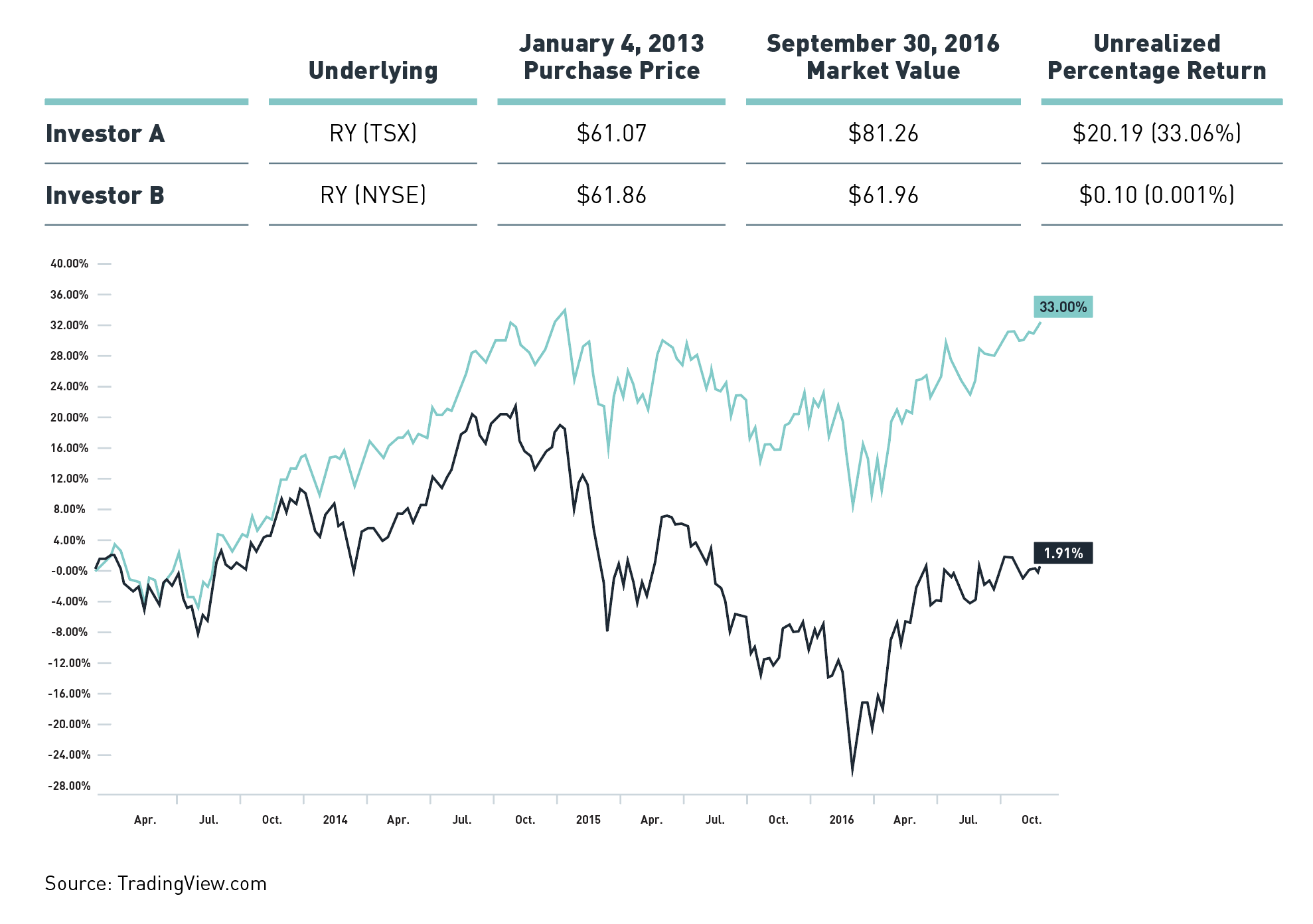Currency Options University – Part 2

Part 2: Impact of U.S. Dollar Fluctuation on Canadian Returns
I had the opportunity, early in my career, to work at a full-service brokerage at a Tier 1 Canadian bank. I remember back in the day overhearing an investment advisor having an argument with a client about the client’s performance. The client was questioning the overall performance when looking at the value of the portfolio in Canadian dollar terms. The advisor was defending himself saying that he was a value investor/stock picker and not a currency trader. At the time I was just learning the ropes and did not fully comprehend the statement.
Currency matters!
It was only years later that I started to understand the macro implications. A weak currency not only acts as a stimulation for a country by making its exports globally more competitive but also often drives its stock markets higher. Let’s try to understand this in more detail.
Our focus here is to cherry pick a real example of how dramatic the returns can be between two investors by a simple decision as to what currency to buy their shares in. I am going back to the 2013 to 2016 period to intentionally capture a meaningful move in the Canadian dollar. For this example, both our investors are keen on owning Royal Bank for both the dividend and upside appreciation.
Back on January 4, 2013 the U.S. dollar was trading near par at 0.9874 to the CAD.
Investor A: Our first investor has a Canadian dollar margin trading account and decides to buy 1,000 shares of Royal Bank (TSX:RY) back on January 4, 2013 at $61.07, which amounts to a $61,070.00 investment made in Canadian dollars.
Investor B: Our second investor has an American dollar margin trading account and also decides to buy 1,000 shares of Royal Bank (NYSE:RY), but does so on the New York Stock Exchange. The shares are purchased on January 4, 2013 at $61.86, which amounts to a $61,860.00 investment in U.S. dollars.
Both investors bought the company for the same reason. A safe dividend and long-term appreciation. The final result proved to be far more divergent than most would think.

The difference?
The U.S. dollar appreciated from 0.9874 to 1.31221 over that timeframe. Now the intelligent and thorough investor may argue that they were no better or worse off if everything was converted back to a Canadian dollar base, but I digress.
How many U.S. dollar denominated investors would feel satisfied that they made a sound investment in Royal Bank shares (NYSE) if they saw no capital appreciation in close to 4 years?
Equally, how many Canadian dollar denominated investors would argue that they were not really up 33.06% on their shares because they lost it on the purchasing value of their domestic currency?
Is it not fascinating how different investors could have such different perceptions on their returns owning the same shares?
The currency you own your investments in is incredibly influential to your final performance. Taking a macro perspective on understanding currency risks is critical for an aspiring investor. Learning when and how to hedge those risks is a valuable tool in helping manage those risks.
Join us for Part 3 where we will take a deeper dive into understanding the specifications of currency options, how they work and if they are right for you.
Disclaimer:
The strategies presented in this blog are for information and training purposes only, and should not be interpreted as recommendations to buy or sell any security. As always, you should ensure that you are comfortable with the proposed scenarios and ready to assume all the risks before implementing an option strategy.
Derivatives Market Specialist
Big Picture Trading Inc.
Patrick Ceresna is the founder and Chief Derivative Market Strategist at Big Picture Trading and the co-host of both the MacroVoices and the Market Huddle podcasts. Patrick is a Chartered Market Technician, Derivative Market Specialist and Canadian Investment Manager by designation. In addition to his role at Big Picture Trading, Patrick is an instructor on derivatives for the TMX Montreal Exchange, educating investors and investment professionals across Canada about the many valuable uses of options in their investment portfolios.. Patrick specializes in analyzing the global macro market conditions and translating them into actionable investment and trading opportunities. With his specialization in technical analysis, he bridges important macro themes to produce actionable trade ideas. With his expertise in options trading, he seeks to create asymmetric opportunities that leverage returns, while managing/defining risk and or generating consistent enhanced income. Patrick has designed and actively teaches Big Picture Trading's Technical, Options, Trading and Macro Masters Programs while providing the content for the members in regards to daily live market analytic webinars, alert services and model portfolios.
The information provided on this website, including financial and economic data, quotes and any analysis or interpretation thereof, is provided solely for information purposes and shall not be construed in any jurisdiction as providing any advice or recommendation with respect to the purchase or sale of any derivative instrument, underlying security or any other financial instrument or as providing legal, accounting, tax, financial or investment advice. Bourse de Montréal Inc. recommends that you consult your own advisors in accordance with your needs before making decision to take into account your particular investment objectives, financial situation and individual needs.
All references on this website to specifications, rules and obligations concerning a product are subject to the rules, policies and procedures of Bourse de Montréal Inc. and its clearinghouse, the Canadian Derivatives Clearing Corporation, which prevail over the content of this website. Although care has been taken in the preparation of the documents published on this website, Bourse de Montréal Inc. and/or its affiliates do not guarantee the accuracy or completeness of the information published on this website and reserve the right to amend or review, at any time and without prior notice, the content of these documents. Neither Bourse de Montréal Inc. nor any of its affiliates, directors, officers, employees or agents shall be liable for any damages, losses or costs incurred as a result of any errors or omissions on this website or of the use of or reliance upon any information appearing on this website.
BAX®, CADC®, CGB®, CGF®, CGZ®, LGB®, MX®, OBX®, OGB®, OIS-MX®, ONX®, SCF®, SXA®, SXB®, SXF®, SXH®, SXM®, SXO®, SXY®, and USX® are registered trademarks of the Bourse. OBW™, OBY™, OBZ™, SXK™, SXJ™, SXU™, SXV™, Montréal Exchange and the Montréal Exchange logo are trademarks of the Bourse. All other trademarks used are the property of their respective owners.
© 2024 Bourse de Montréal Inc. All Rights Reserved.
